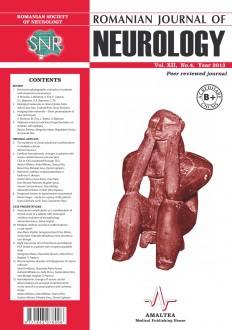SELECT ISSUE

Indexed

| |

|
|
|
| |
|
|
|

|
|
|
|
|
|
| |
|
|
HIGHLIGHTS
National Awards “Science and Research”
NEW! RJN has announced the annually National Award for "Science and Research" for the best scientific articles published throughout the year in the official journal.
Read the Recommendations for the Conduct, Reporting, Editing, and Publication of Scholarly work in Medical Journals.
The published medical research literature is a global public good. Medical journal editors have a social responsibility to promote global health by publishing, whenever possible, research that furthers health worldwide.
BRAINSTEM AUDITORY EVOKED POTENTIALS IN PARKINSON’S DISEASE
Daniel Alexa, Laura Alexa, Livia Popa, Dan Nicolae Paduraru, Bogdan Ignat, Aurora Constantinescu, Doru Baltag, Alexandrina Rotar and Cristian Dinu Popescu
ABSTRACT
Background. Parkinson’s disease is a neurodegenerative disorder caused by loss of dopaminergic neurons in the substantia nigra, but also in other dopaminergic and nondopaminergic areas of the brain and mainly in the brainstem. Auditory evoked potentials are routinely used in clinical practice to evaluate the function of the auditory nerve and auditory pathways in the brainstem. The aim of this study was to investigate the auditory brainstem pathways in patients with Parkinson disease.
Materials and methods. In this study was included 34 patients with Parkinson’s disease. The control group was composed of 29 healthy age- and sex-matched subjects. Detailed examination were performed in all individuals and the parkinsonian patients were stage between 2 and 4 according to Hoehn and Yahr’s classication. Recordings of BAEPs were performed with Nihon Kohden Neuropack using 80 dB HL alternating polarity clicks in each ear at a rate of 10 s-1.. Averaged potentials to 1,000 clicks were obtained.
Results. The BAEP results were interpreted for the latencies of waves I, II, III, IV, V and Interpeak Latencies (IPL) I-III, III-V and I-V. The results of our study have shown that the waves II, III, IV, V and IPL III-V were significantly delayed bilaterally. This modifications does not correlates with the age or duration of disease
Conclusion. This study showed some modifications of auditory evoked potentials wich can be determined by the neurodegenerative process that affects the brainstem.
Keywords: Parkinson disease, auditory evoked potentials, auditory pathways
